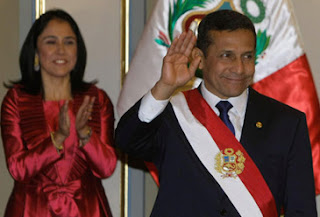LIMA, Peru — Ollanta Humala, the leftist military man who won Peru's presidency after abandoning a radical platform, promised in his inaugural address Thursday to make his priority the one in three Peruvians still mired in poverty.
The 49-year-old former army lieutenant colonel charted a plan for spreading the wealth from Peru's mineral boom beyond Lima, where it has been concentrated among a small elite, to long-neglected hinterlands.
"Peru's peasants and the poor in the countryside in general will be the priority," Humala said in remarks before a newly installed Congress and dignitaries who included 11 presidents, almost all from South America.
He quoted South Africa's anti-apartheid hero and former president, Nelson Mandela, in arguing there can be no democracy where misery and "social asymmetry" persist.
Humala's will be a daunting juggling act: He also signaled his intention to maintain the business status quo and honor all international pacts, including a raft of free-trade agreements enacted by his predecessors.
To reassure foreign investors, Humala retained the incumbent central bank chief, Julio Velarde, and named as finance minister Luis Miguel Castilla, a deputy finance minister for the past year and a half in the outgoing government of President Alan Garcia.
The Cabinet is dominated by moderate technocrats but also includes, as culture minister, the renowned singer Susana Baca. She is Peru's first black Cabinet member.
Humala didn't explain how he planned to pay for the generous social programs he catalogued Thursday, most of which he promised during the campaign, though he has said he intends to seek taxes on windfall mining profits.
The pledges include modest old-age pensions for Peruvians at age 65, beginning with the neediest; raising the minimum monthly wage in two stages from $218 to $270 by next year; free preschools in Peru's poorest districts, college scholarships for top-performing needy students and building hospitals in 50 cities where they're lacking. The first minimum wage increase — $27 — is slated for next month.
Humala also promised to invest in public transportation in the traffic-choked capital of Lima; to expand highways and railways; to rebuild Peru's merchant marine and to re-establish a national airline. Aeroperu went bankrupt in 1999.
He said he would dedicate more natural gas from the Camisea field for domestic use rather than export, and has promised to lower natural gas prices, though he did not mention a target price.
Humala won't have an easy time in Congress, where his party has just 47 of 130 seats and will have to depend on lawmakers from the Peru Posible party of former President Alejandro Toledo for a majority.
Humala’s history as a revolutionary is well documented, in 2000 he lead a successful uprising against the President at the time Alberto Fujimori who was accused and later convicted of multiple corruption charges and is currently serving twenty five years in prison. The catalyst for the revolution was the return of former Intelligence Chief Vladimiro Montesinos who had fled Peru for Panama after being caught bribing an opposition congressman to switch sides to the ruling party, his return indicating to Humala that Montesinos still had considerable influence within the government of the day. The subsequent investigations into Montesinos provided a litany of illegal activities including involvement drug trafficking and the smuggling of firearms. Alberto Fujimori was convicted of human rights abuses, murder and kidnapping charges, among others. Following the revelations Humala was pardoned by congress and free to resume his role in the military, after which he retired in 2004 and became leader of the National Party of Peru in 2005.
Keiko Fujimori, daughter of Alberto Fujimori, was running against Humala in the election, which was only narrowly won by Humala with 51.49% of the vote. Humala has acknowledged that to accomplish his goals in office he needs to work with all sides of the congress as his party lacks a majority in the house, however he caused controversy during the swearing in by promising to abide by the constitution of 1979 and not the revised 1993 model created by Alberto Fujimori, sparking outrage from the opposition party. Humala has set ambitious goals for Peru in the coming years and has already begun to deliver on some of the promises he made during the campaign, one of his first acts in office has been the raise the minimum wage to a monthly 750 soles, which is equivalent to $275US, and announced a pension plan for all over the age of 65.
Other policies to be put in place are to supply Peruvian natural gas to Peruvians as a priority and then to be exported, mediate over 200 conflicts in rural areas, fight drug trafficking by replacing cocaine fields with coca, honour all previous international pacts and free trade agreements that we enacted under the previous government, invest in public transport and re-establish the defunct national airline Aeroperu which ceased in 1993. All while continuing to keep a strong economy, which he plans to maintain by modernizing Peru’s agricultural industry.














